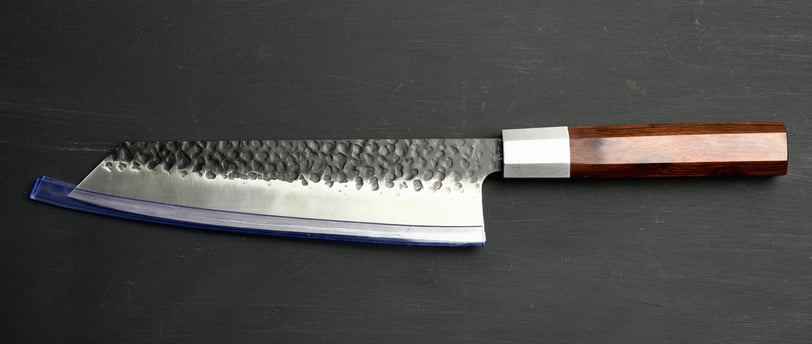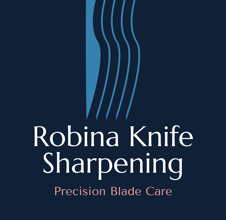Robina Knife Sharpening Book in for same-day service 0466 156 237 4 TIFFANY CLOSE. ROBINA
7 Signs Your Kitchen Knives Need Professional Sharpening
Learn the key signs that indicate your kitchen knives need professional sharpening to ensure safety and enhance food preparation.
4/24/20256 min read


7 Signs Your Kitchen Knives Need Professional Sharpening
Dull knives slow you down and increase injury risks. If your food prep feels harder or your cuts look messy, it’s time to sharpen your blades. Here are the 7 key signs your knives need professional care:
Food Resists Cutting: Struggling with soft foods like tomatoes? A sharp knife should glide through effortlessly.
Jagged Cuts: Uneven slices or torn herbs mean your blade has lost its edge.
Extra Force Needed: If cutting feels like a workout, your knife is too dull.
Blade Slips Off Food: Skidding on tough surfaces like pumpkin is a clear danger sign.
Food Gets Squashed: Crushed veggies or bruised greens ruin flavour and texture.
Visible Blade Damage: Chips, bent tips, or loose handles compromise performance and safety.
Honing Doesn't Help: If honing fails to restore sharpness, professional sharpening is essential.
Why sharpen professionally? It restores precision, improves safety, and extends your knife’s life. Most services cost around $20–$25 per knife and should be done every 6–12 months. Regular honing helps maintain sharpness between services.
Keep your knives sharp for safer, faster, and better food prep.
Sign 1: Food Resists Cutting
One clear indicator that your kitchen knives need sharpening is when soft foods, like tomatoes, are difficult to cut.
The Tomato Test
Try slicing a tomato or onion. A sharp knife should glide through smoothly, creating clean and precise cuts. If your knife crushes the tomato or struggles to pierce the skin, it’s time to get it sharpened.
"If your knife smashes the tomatoes and the skin comes off separately, it's time to sharpen the blade." [3]
Slower and Riskier Food Prep
A dull knife not only slows down meal prep but also increases the risk of accidents. When you need to apply extra pressure, it can lead to:
Slips, making it harder to control the blade
Strain on your hands and wrists
Torn or damaged ingredients
Longer preparation times
"A dull knife is a kitchen nightmare. It drags, forces you to apply more pressure, and ultimately slows down every cut." [1]
"Blunt knives can be dangerous. Having them sharpened means they do the job with less forceful effort from you, reducing the risk of losing control over the blade and accidentally injuring yourself." [4]
Addressing these issues early helps maintain your knives' performance and keeps your kitchen safer.
Sign 2: Cuts Look Rough and Uneven
If your cuts appear jagged or inconsistent, it’s a clear sign your knives need sharpening. Sharp knives are essential for clean, precise cuts that not only improve presentation but also maintain ingredient quality.
Common Problems with Dull Blades
When knives lose their edge, you might notice:
Torn edges on herbs
Crushed vegetable fibres
Jagged meat surfaces
Irregularly sized pieces
"A sharp blade makes slicing effortless and precise."
How Rough Cuts Affect Your Cooking
Uneven cuts don’t just look bad - they can also impact how your food cooks and tastes:
Damaged vegetable cells oxidise faster, leading to browning
Unevenly sized pieces result in inconsistent cooking
Torn herbs release too much moisture, affecting flavour
Meat with damaged fibres loses its juices, reducing tenderness
Take a close look at your sliced ingredients. If you see tearing, crushing, or uneven patterns, it’s time to get your knives professionally sharpened. These imperfections not only affect your dish’s visual appeal but also its overall quality.
Sign 3: Pushing Too Hard While Cutting
If you find yourself applying extra pressure to cut food, it’s a clear sign your knife needs sharpening. A well-maintained knife should require little effort, making clean cuts almost effortless.
Studies show that dull knives demand much more effort to cut through ingredients, leading to physical strain and slower work in the kitchen [1].
Increased Risk of Injury
Using excessive force with a dull knife can be dangerous. Statistics reveal that nearly one-third of injuries among 15–24-year-olds involve cuts from handling knives [5].
Here’s why dull knives are risky:
The blade may slip off the food surface.
Overexertion can lead to muscle fatigue and loss of control.
There’s a higher chance of sprains and strains.
Getting your knife professionally sharpened can address these issues. A sharp blade cuts smoothly, reducing resistance and giving you better control. This not only makes cutting safer but also protects your hands and wrists from unnecessary strain.
In the next section, we’ll explore how dull knives can slip off food surfaces, creating additional safety hazards.
Sign 4: Blade Slides Off Food
If your knife slides off food instead of cutting through it, it’s time to consider professional sharpening. This often happens when slicing firm fruits or vegetables and can create serious safety hazards.
Why Knives Slip
A dull blade struggles to grip and penetrate food, especially those with tough skins or hard surfaces. Instead of cutting, the knife skids or deflects, increasing the chance of accidents.
This slipping not only makes cutting frustrating but also increases the likelihood of injury.
Why Control Matters
Slipping blades reduce your ability to control the knife, making cutting unpredictable. As We Sharpen Knives explains:
"Blunt knives can be dangerous. Having them sharpened means they do the job with less forceful effort from you, reducing the risk of losing control over the blade and accidentally injuring yourself" [4].
When control is compromised, you may experience:
The blade veering off its intended path
Needing extra force to start cuts
Unpredictable knife movements
A higher risk of the knife slipping toward your hand
If your knife is consistently slipping and control is an issue, it’s a clear sign to have it professionally sharpened.
Sign 5: Food Gets Squashed
Blunt knives don't cut cleanly - they crush. This not only affects how your food looks but also its taste and quality.
"Dull knives silently sabotage your culinary efforts by crushing and bruising ingredients instead of creating clean cuts" [6]
Messy Presentation and Lost Flavour
Blunt knives don't just harm food physically - they also ruin its appearance and taste. When your ingredients are squashed instead of sliced, you may notice:
Faster browning due to oxidation, making food look less fresh
A loss of texture and crispness
Flavours spilling out and going to waste
To keep your food looking and tasting its best, ensure your knives stay sharp. Professional sharpening can restore your blade's precision edge [7], letting you cut instead of crush. If your food prep feels more like mashing than slicing, it's time to sharpen up.
Sign 6: Damaged Blade Edge
If your knife shows physical damage - like chips, a bent tip, a loose handle, or stress marks along the blade - it’s time to get it professionally repaired. These issues can compromise both safety and usability.
Always use proper lighting during inspections, and never test the edge with your fingers - damaged blades remain sharp and dangerous.
Why Quick Repairs Matter
Ignoring small issues can lead to bigger problems. For instance, a minor chip can grow into a crack, and a bent tip can compromise the blade’s overall structure. Professional services can address these problems by:
Grinding out chips for a smooth edge
Realigning bent tips
Securing loose handles
Refinishing edges to restore cutting precision
"Prompt blade repairs not only restore the functionalities of your knives but also prevent further damages that may occur if left unaddressed." [2]
Repairing your knives is far more economical than replacing them. Standard kitchen knife repairs typically start at $20, while more specialised fixes may cost around $25. This small investment ensures your knives stay sharp, safe, and long-lasting.
If regular maintenance isn’t enough to bring your blade back to life, move on to Sign 7 for more guidance on when honing alone won’t cut it.
Stop using any knife with visible damage immediately. Continuing to use a compromised blade not only affects food preparation but also increases the risk of accidents. Seek professional sharpening services as soon as possible.
Sign 7: Honing No Longer Works
When honing stops improving your blade, it's a clear sign that at-home maintenance has reached its limit. Honing helps maintain a knife's edge by realigning it, but sharpening is what actually rebuilds the edge when it's too far gone.
Why Professional Sharpening Matters
Unlike honing, professional sharpening restores your blade to its original sharpness. Most knives only need this service once or twice a year, while regular honing keeps them performing well in the meantime. For example, a sharpening service costing $20 per knife provides a great return in terms of safety and cutting efficiency.
Keep honing as part of your routine, but when it stops working, professional sharpening is the best way to restore your knife's edge. It removes only a small amount of material while bringing your blade back to peak condition.
Conclusion: Getting Professional Knife Care
Professional knife sharpening goes beyond what you can achieve with basic at-home maintenance. As expert Greg Hollmann puts it:
"Tuning up your edges with a steel is like brushing your teeth; having your knives sharpened is like going to the dentist" [9].
For those who use their knives daily - especially for tasks like cutting meat - it's recommended to sharpen them every three months. Chef's knives, in particular, may need even more frequent attention [10]. This level of care ensures your knives stay in peak condition.
With prices typically around $20 for standard knives and $25 for specialty blades, professional sharpening is a worthwhile investment to keep your tools performing at their best for years to come.
Contact
© 2025. All rights reserved.
4 Tiffany Close
Robina 4226

